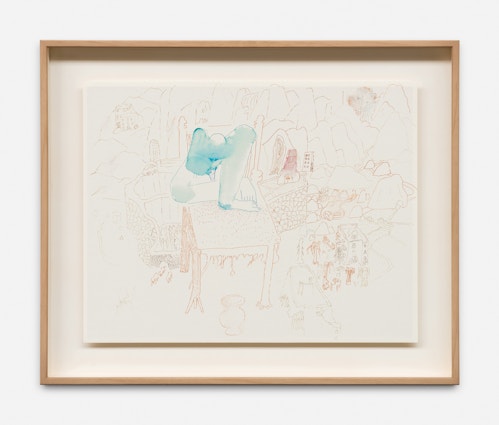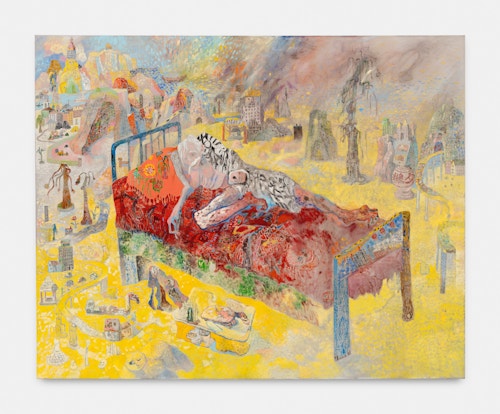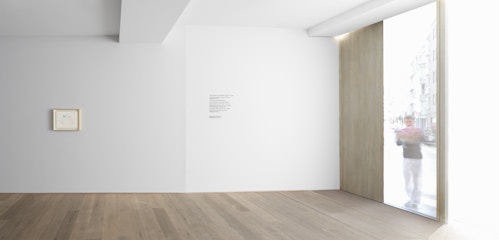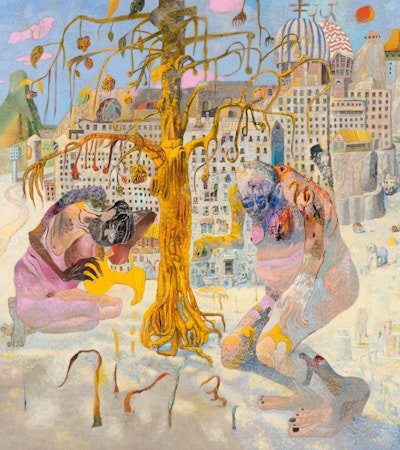
Qiu Xiaofei BARE
Xavier Hufkens is pleased to present Chinese artist Qiu Xiaofei’s debut exhibition in Europe. Entitled BARE, the presentation showcases a new series of paintings created between 2021 and 2023. Referencing Eastern and Western aesthetic traditions, while also drawing on the literary, musical, and intellectual worlds of both cultures, the works straddle the border between observation and imagination, exploring the depths of human consciousness and the boundaries of reality.
The title of the exhibition alludes to a famous sentence from the poem First Day of the Year Wu Shen by the Ming Dynasty writer, Wang Zhideng (1535- 1612): “Bare-skinned, I pound the drum with unrestrained fervour, unleashing my untamed soul.” The poem tells of a man who ages overnight and awakens on the first morning of the New Year naked, entering a state of mania, as he fervently searches for his most authentic inner self. By conjuring up the image of a naked man beating the drum, Qiu depicts this unbridled attitude to life and a desire to transcend its mundanity in his works.
In recent years, Qiu has returned to one of the leitmotivs in his oeuvre: the exploration of madness, hallucinations, and the irrational energy of the
human psyche. Inspired by psychoanalysis which links the ideas of dreams,
nakedness, and self-image, Qiu seeks to penetrate the superficial aspects of
life and to uncover deeper existential insights through painting. For Qiu,
painting serves not only as an interaction between physical sensation and the mind, but also as an evocation of spiritual energy, aiding us in navigating
the complexities of existence. Combining vivid colours with the exaggerated
deformities and Aesopian language of magical realism, the painting Drunken
Moon takes its name from composer Arnold Schoenberg’s Pierrot lunaire (1912),
a melodrama known for its neurotic atmosphere (Moondrunk is the title of the
first song in the series). The narratives in Schoenberg’s multi-part composition
are reflections on the inner psyche, appearing as impulsive yet authentic
expressions that emerge from the depths of the subconscious.

In Qiu’s works, the philosophical ideas of Chinese literati from the Wei and Jin (220-420) dynasties are reimagined as contemporary images: faces with ambivalent smiles, the chaos of inebriated dances and chants, and naked bodies, all set amidst strange flowers and plants in utopian ruins. The influences of traditional Eastern painting and European religious art of the late Middle Ages are also evident in his work: the use of aerial views creates a spacious realm for contemplation, while scattered perspectives and lines delineate deep mountains and desolate terrains, forming a thought-provoking imagery. Traditional Chinese art’s significant influence is noticeable in the painting Bare, evoking the concise depictions of the Arhat found in traditional Chinese art. With an extensive use of yellow, the painting evokes a striking apocalyptic landscape that, despite its grandeur, is collapsing into decay with a frail body on a bed. As the place where life begins and ends, this specific motif conveys both positive and negative connotations.
The artist’s inspiration further extends from personal recollections of his family to the geopolitical relationship between his hometown of Harbin, in China, and the former Soviet Union. These influences are visible in works such as The One Tree Forest and La Source, where the imagery of the deserted church and labourer’s shelter from his hometown combines to form futuristic architectures. Such distinctive architectures serve as vehicles for the artist’s recollections and fantasies, further merging the threads of past and present, the individual and collective, and observation and imagination.
In BARE, Qiu offers a profound exploration of reality and the human psyche, reflected in the mystical allure of his paintings. Drawing from memory, fantasy, and historical references, his works unveil the depths of human consciousness while seamlessly blending Eastern and Western aesthetics across different time periods. Transcending mere representation, Qiu’s paintings invite the viewer to delve deeper into the complexities of existence in a dream-like manner.
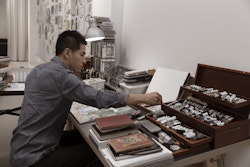
Qiu Xiaofei (b. 1977, Harbin, China) graduated from the Central Academy of Fine Arts Beijing in 2002, and now lives and works in Beijing. His work has been featured in major exhibitions internationally, including in M+, Hong Kong (2023); Taikang Art Museum, Beijing (2023); G Museum, Nanjing (2023); UCCA Edge, Shanghai (2022); He Art Museum, Guangdong (2021); Fort Gansevoort, New York (2018); Crystal Bridges Museum of American Art, Bentonville (2018); Tampa Museum of Art, Florida (2014); Museum Boijmans Van Beuningen, Rotterdam (2014); Ullens Center for Contemporary Art, Beijing (2013); Long Museum, Shanghai (2013); The 10th Havana Biennial, Havana (2009); Tate Liverpool, Liverpool (2007); ZKM | Museum of Contemporary Art, Karlsruhe (2007); Kunstmuseum Bern, Switzerland (2005).


